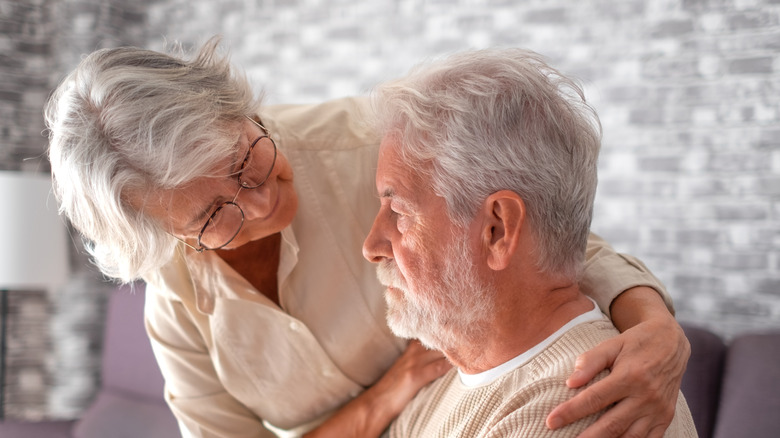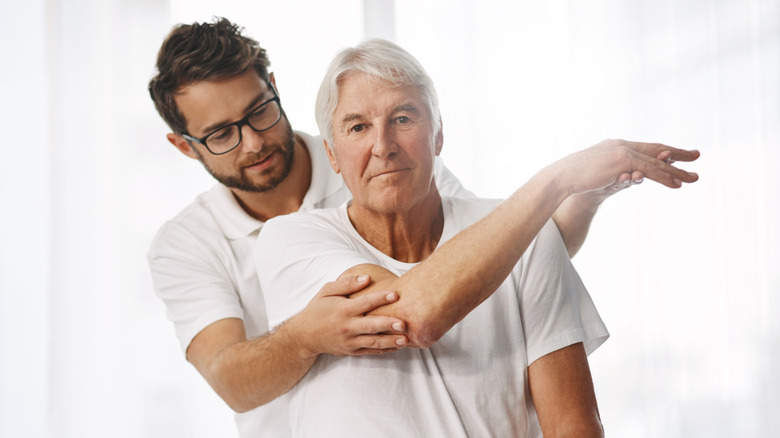You're More Susceptible To This Injury If You Have Dementia
Often, when we think of the symptoms of dementia, we imagine a person who is struggling with memory or thought. However, as Healthline explains, dementia can go beyond cognitive problems, also including certain physical symptoms such as instability, lack of muscle control, and changes in posture.
Dementia posturing can significantly increase a person's risk of injury, especially as the condition progresses. Abnormal postures—such as stooping, swaying, shuffling, or freezing—can interfere with balance, coordination, and spatial awareness, making everyday movements more hazardous.
As posture becomes less stable, individuals are more prone to falls, which are a leading cause of injury among people with dementia. Muscle weakness and rigid or jerky movements can also limit the body's ability to react quickly to prevent a fall or recover from an off-balance position.
Over time, these physical challenges may lead to fractures, head trauma, or a general loss of mobility — factors that can accelerate both physical and cognitive decline. In this way, the motor symptoms associated with dementia posturing create a cycle of increasing frailty and injury risk that requires careful monitoring and proactive support.
What causes dementia posturing
According to myALZteam, dementia leads to the gradual loss and death of brain cells (neurons), which causes the brain to shrink, or atrophy. As neurons die off, the brain loses its ability to send and receive signals that guide how the body moves and stays upright. When the areas of the brain responsible for posture, balance, and motor control—such as the brainstem or the frontal cortex—are affected, changes in movement become more noticeable. (Here's what causes your risk of dementia to go up.)
Damage to the brainstem, for example, can lead to poor balance, muscle weakness, difficulty walking, and even changes in heartbeat or breathing. Meanwhile, damage to the frontal cortex can affect muscle control and coordination, increasing the risk of falls.
Since many types of dementia affect more than one part of the brain, it's common for posturing symptoms to appear alongside memory loss, confusion, or mood changes. The more severe the damage or the more critical the area affected, the more obvious the physical symptoms tend to be.
How dementia posturing is managed
Managing dementia posturing requires a multifaceted approach that addresses both the physical and emotional needs of the individual, says Knowridge Science Report. Though dementia posturing can be challenging, early recognition and supportive care can make a meaningful difference in comfort, function, and dignity. (Learn more about how dementia is treated.)
Physical therapy plays a key role in helping to maintain mobility and prevent complications like contractures, where muscles become stiff and shortened due to prolonged rigidity. Gentle stretching, range-of-motion exercises, and regular movement can help reduce discomfort and preserve joint flexibility. Occupational therapy may also be used to adapt daily activities and provide supportive tools—such as cushions, braces, or modified clothing—to make care easier and safer. In some cases, medications that reduce muscle stiffness or spasms may be considered, though they must be used with caution due to potential side effects in older adults.
Caregivers are central to managing posturing. Frequent repositioning, supportive bedding, and a calm, structured routine can all help reduce discomfort and lower the risk of pressure sores and injury. Encouraging daily activity and maintaining a comforting environment can also improve quality of life.


